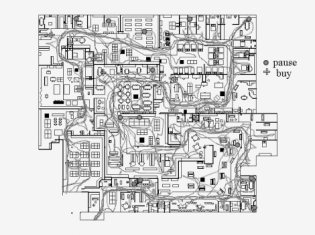
The image is an arresting one, content orbiting around a new center of gravity. Cameron Koczon, is his essay Orbital Content, addresses what he sees as a new breed of bookmarklet: Instapaper, Svpply and Readability. These applications allow a user to extract content from its original location—and then copy and transmit it to a personal archive. With Instapaper and Readability this may involve using a bookmarklet on a desktop-based web browser to DVR a long-form article from a publisher’s web site for later consumption on an iPad. With Svpply, it may be extracting a favorite item from an online eCommerce site to create a cross-domain curated scrapbook stream that’s shared in a social media context. Content exists as free satellites, plucked from their originating orbits and placed into a personal orbit.
The bookmarklet application occupies an interesting space. It sits at the edge of a desktop application—the browser—and operates on “pages” requested by the browser from servers on the Network. Rather than simply creating a shortcut to a specific URL, the bookmarklet is javascript code that runs on the current page. Because it holds this outside position, it can mix together code from multiple domains, blending the intentions of the page publisher, data or snippets from other sources, and the intentions of the user. In the case of “orbital content,” the bookmarklet is the transport mechanism, the user pushes a button and specified content is instantly transported from the orbit of one sun to another. Koczon’s enthusiasm about these new bookmarklet-based services begs the question whether browserOS apps can gain awareness in the popular imagination.

While the idea of a new orbit is quite exciting, we still seem to be stuck with the word “content.” The very word “content” has engendered a certain amount of discontent. It turns the fire of the written word into a bland abstraction. It’s the equivalent of a factory that turns out “widgets.” It’s the sausage that’s ground through content management systems. When speaking of this new orbital stuff, content seems exactly the wrong word. Content is the thing which is contained—the stuff inside of the boundary. In the case of orbital content, we are not content. The word “content” also refers to a state of happiness—being content. There’s a sense of acceptance of conditions or circumstances, of acquiescence. In neither sense of the word can this new orbital stuff be called content. We do not acquiesce to its circumstances—we break it out of its container and pull it into a new orbit.
We treat the digital as another kind of analog medium. Since it can simulate anything, we extend the analog by simulating it with the digital. In vain, we then attempt to impose the natural boundaries of analog economics onto the digital. By stamping these limitations onto the digital, we put it into analog clothes and ask everyone to behave accordingly. To mass produce significant quantities of “identical” analog objects requires an industrial-scale factory. An identical digital object is forged each time a request is made to a web server on the Network. The original bits aren’t transported from here to there, copies of the bits are distributed to anyone who asks—production is reproduction, presentation is representation.
This is major Tom to ground control, I’m stepping through the door
And I’m floating in a most peculiar way
And the stars look very different today
Here am I floatin’ ’round my tin can far above the world
Planet Earth is blue and there’s nothing I can doThough I’m past one hundred thousand miles, I’m feeling very still
And I think my spaceship knows which way to go
The digital can be passed by reference or by value over the Network. The first preserves the integrity of the data, always pointing back to a single source—pointers rather than copies of bits are passed around. An updated source doesn’t require an updated pointer. A source could change incrementally, or totally, and still employ the same pointers. The second method begins the process of entropy, time-stamped bits are copied and sent, but once out on the wire, their link to the source is broken. An updated source marks a difference with the distributed bits. When the source changes, the distributed copy inscribes a historical state of the source. With every incremental change to the source, the difference in the distributed copy grows.

The kind of copying done in the practice of orbital content is digital rather than analog. Traditionally, the value of a copy has been in its completeness and exactitude. A factory that turns out widgets that sport too much variance is said to have a quality assurance problem. When Instapaper copies, it copies the pointer for exactness and then only a portion of a web page. The digital can make wholes out of any parts—there’s a legible boundary between every one and zero. It can be compared to harvesting a food crop, the ears of corn are gathered and the stalk and roots are discarded. To a publisher, this is a description of stripping the business model from the editorial.
The publisher asks the digital to behave as previous mediums always have—ink, once it is imprinted on paper, has a permanent presentation. Television programs are broadcast and the screen passively plays them. We can take a pen and draw a mustache on a photo in the newspaper, or mute the sound of our favorite television show while the commercial plays, but there’s a higher bar to clipping out segments and reusing them for our own purposes. Analog forms of automating the process have proved too costly and cumbersome.

All the while we thrill and lament the rush of traditional media toward the digital, we still tend to view it through analog glasses. The web page as delivered from the server to the browser is meant to define an end point. The code is delivered and ready for presentation. The static page is given a sense of flow and time with AJAX-based page updates from backstage, altering the presentation in memory through manipulations of the document object model (DOM). The practice of orbital content takes the page, not as an endpoint, but as an input to a process. Shedding their analog clothes, the digital bits making up the page show themselves not as an ending, but as a potential beginning. Using Instapaper, I pipe a designated section of the page, the story I’d like to read later, to my reading room where it’s poured into the format I prefer for reading electronic documents. I define a new endpoint, but it could also be a potential starting point as some portion is shared in another context.
In general, the browser application space (bookmarklets) has made significant strides, it’s gained a cross-platform software infrastructure with Phil Windley’s event-driven scripting language, KRL (Kynetx). And Apple has taken Readablity and Instapaper seriously enough to incorporate similar functionality into the forthcoming browser operating system in Lion. This follows the historical pattern of fundamental features being absorbed into the infrastructure of the host platform. The larger picture is that “web pages” are now both machine readable and scriptable for individuals, something known to the spiders at Google for a long time. No need to wait for the so-called semantic web, the hooks are already there.

David Gelernter defined an alternative to the desktop metaphor called LifeStreams. Instead of named files in folders, inside of folders, inside of desk drawers—nothing needs to be named, things just appear in context in a time-stamped stream. Streams can be filtered by different contexts, organized in time rather than space. Future events put into the stream eventually pop up as something occurring today. With Facebook’s newsfeed, Twitter’s stream, the various photo and location services, we’ve become accustomed to dealing with ranked lists and time-ordered streams. Even the output of these new orbital content services generally takes the form a of stream. In other words, orbital content isn’t really orbital either.
But the metaphor is enchanting enough to do the thought experiment, to take the stream and bend it into a circular shape, an orbit. Timelines are one way of expressing time, but we also have a long history with circular time. We live through hours, days, weeks, months, seasons and years. These things we DVR for later, might actually take the shape of satellites circulating in a personal orbit. Sort of like editing and layering loops, but using more than digital samples of music. What goes around, comes around—imagine orbital content as orbiting content.









